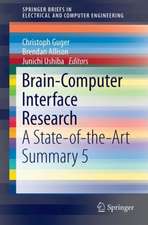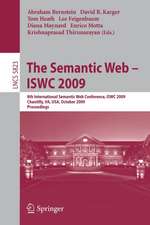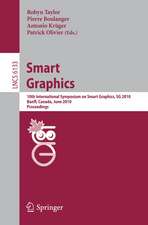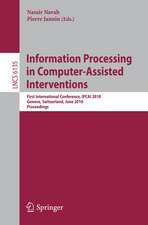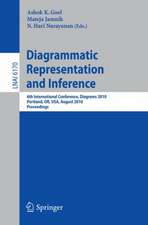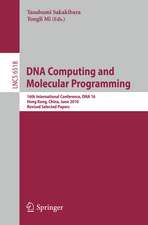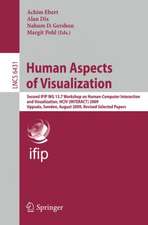Smart Textiles: Fundamentals, Design, and Interaction: Human–Computer Interaction Series
Editat de Stefan Schneegass, Oliver Amften Limba Engleză Hardback – 10 feb 2017
Leading experts from different domains including textile production, electrical engineering, interaction design and human-computer interaction (HCI) address production processes in their entirety by exploring important concepts and topics like textile manufacturing, sensor and actuator development for textiles, the integration of electronics into textiles and the interaction with textiles. In addition, different application scenarios, where smart textiles play a key role, are presented too.
Smart Textiles would be an ideal resource for researchers, designers and academics who are interested in understanding the overall process in creating viable smart textiles.
| Toate formatele și edițiile | Preț | Express |
|---|---|---|
| Paperback (1) | 717.43 lei 39-44 zile | |
| Springer International Publishing – 9 sep 2018 | 717.43 lei 39-44 zile | |
| Hardback (1) | 1175.42 lei 3-5 săpt. | |
| Springer International Publishing – 10 feb 2017 | 1175.42 lei 3-5 săpt. |
Din seria Human–Computer Interaction Series
- 20%
 Preț: 655.85 lei
Preț: 655.85 lei - 20%
 Preț: 309.27 lei
Preț: 309.27 lei - 20%
 Preț: 375.54 lei
Preț: 375.54 lei - 20%
 Preț: 644.48 lei
Preț: 644.48 lei - 20%
 Preț: 667.75 lei
Preț: 667.75 lei - 20%
 Preț: 664.44 lei
Preț: 664.44 lei - 20%
 Preț: 1164.84 lei
Preț: 1164.84 lei - 20%
 Preț: 817.55 lei
Preț: 817.55 lei - 20%
 Preț: 657.16 lei
Preț: 657.16 lei - 20%
 Preț: 645.31 lei
Preț: 645.31 lei - 20%
 Preț: 938.66 lei
Preț: 938.66 lei - 15%
 Preț: 658.05 lei
Preț: 658.05 lei - 20%
 Preț: 822.51 lei
Preț: 822.51 lei - 20%
 Preț: 654.21 lei
Preț: 654.21 lei - 20%
 Preț: 994.26 lei
Preț: 994.26 lei - 20%
 Preț: 1621.89 lei
Preț: 1621.89 lei - 20%
 Preț: 991.60 lei
Preț: 991.60 lei - 20%
 Preț: 783.46 lei
Preț: 783.46 lei - 20%
 Preț: 659.97 lei
Preț: 659.97 lei - 20%
 Preț: 219.15 lei
Preț: 219.15 lei - 20%
 Preț: 334.86 lei
Preț: 334.86 lei - 20%
 Preț: 969.85 lei
Preț: 969.85 lei - 20%
 Preț: 642.19 lei
Preț: 642.19 lei - 20%
 Preț: 314.39 lei
Preț: 314.39 lei - 20%
 Preț: 661.14 lei
Preț: 661.14 lei - 20%
 Preț: 995.89 lei
Preț: 995.89 lei - 20%
 Preț: 752.59 lei
Preț: 752.59 lei - 20%
 Preț: 990.30 lei
Preț: 990.30 lei - 20%
 Preț: 990.12 lei
Preț: 990.12 lei - 20%
 Preț: 336.21 lei
Preț: 336.21 lei - 20%
 Preț: 334.71 lei
Preț: 334.71 lei - 20%
 Preț: 312.62 lei
Preț: 312.62 lei - 20%
 Preț: 994.92 lei
Preț: 994.92 lei - 20%
 Preț: 331.74 lei
Preț: 331.74 lei - 20%
 Preț: 646.80 lei
Preț: 646.80 lei - 20%
 Preț: 334.86 lei
Preț: 334.86 lei - 20%
 Preț: 994.40 lei
Preț: 994.40 lei - 20%
 Preț: 329.76 lei
Preț: 329.76 lei - 20%
 Preț: 332.24 lei
Preț: 332.24 lei - 20%
 Preț: 992.11 lei
Preț: 992.11 lei - 20%
 Preț: 650.40 lei
Preț: 650.40 lei - 20%
 Preț: 337.00 lei
Preț: 337.00 lei - 20%
 Preț: 332.39 lei
Preț: 332.39 lei - 20%
 Preț: 1279.86 lei
Preț: 1279.86 lei - 15%
 Preț: 636.12 lei
Preț: 636.12 lei - 20%
 Preț: 336.67 lei
Preț: 336.67 lei - 20%
 Preț: 1000.70 lei
Preț: 1000.70 lei - 20%
 Preț: 645.14 lei
Preț: 645.14 lei
Preț: 1175.42 lei
Preț vechi: 1469.28 lei
-20% Nou
Puncte Express: 1763
Preț estimativ în valută:
224.92€ • 240.51$ • 187.53£
224.92€ • 240.51$ • 187.53£
Carte disponibilă
Livrare economică 27 martie-10 aprilie
Preluare comenzi: 021 569.72.76
Specificații
ISBN-13: 9783319501239
ISBN-10: 3319501232
Pagini: 396
Ilustrații: IX, 396 p. 199 illus., 135 illus. in color.
Dimensiuni: 155 x 235 x 27 mm
Greutate: 0.9 kg
Ediția:1st ed. 2017
Editura: Springer International Publishing
Colecția Springer
Seria Human–Computer Interaction Series
Locul publicării:Cham, Switzerland
ISBN-10: 3319501232
Pagini: 396
Ilustrații: IX, 396 p. 199 illus., 135 illus. in color.
Dimensiuni: 155 x 235 x 27 mm
Greutate: 0.9 kg
Ediția:1st ed. 2017
Editura: Springer International Publishing
Colecția Springer
Seria Human–Computer Interaction Series
Locul publicării:Cham, Switzerland
Cuprins
Introduction to Smart Textiles.- Precision Fabric Production in Industry.- Textile Pressure Force Mapping.- Strain and Angular Sensing Fabrics for Human- Motion Analysis in Daily Life.- Integrated Non-Light-Emissive Animateable Textile Displays.- Haptic Feedback for Wearables and Textiles Based on Electrical Muscle Stimulation.- Textile Antennas.- Electronics Integration.- Reversible Contacting for Smart Textiles.- Energy Harvesting Smart Textiles.- A Strategy for Material-Specific e-Textile Interaction Design.- Designing for Smart Clothes and Wearable’s: A User Experience Design Perspective.- Designing (inter)active Costumes for Professional Stages.- Textile Building Blocks: Towards Simple, Modularized and Standardized Smart Textiles.- Smart Textiles and Smart Personnel Protective Equipment.- Textile Integrated Wearable Technologies for Sports and Medical Applications.- E-Garments: Future as ‘Second Skins’?.
Notă biografică
Stefan Schneegass is a Research Associate within the Human-Computer Interaction group at University of Stuttgart. His current research interest centres on ubiquitous computing and human-computer interaction (HCI) particularly wearable computing and usable security.Oliver Amft is a Full Professor at University of Passau, Germany and head of the Chair of Sensor Technology, whose research focuses on ubiquitous sensor technology, smart textiles, multi-modal context pattern recognition, and human behavior inference algorithms with applications in healthcare, sports, and building technologies.
Textul de pe ultima copertă
From a holistic perspective, this handbook explores the design, development and production of smart textiles and textile electronics, breaking with the traditional silo-structure of smart textile research and development.
Leading experts from different domains including textile production, electrical engineering, interaction design and human-computer interaction (HCI) address production processes in their entirety by exploring important concepts and topics like textile manufacturing, sensor and actuator development for textiles, the integration of electronics into textiles and the interaction with textiles. In addition, different application scenarios, where smart textiles play a key role, are presented too.
Smart Textiles would be an ideal resource for researchers, designers and academics who are interested in understanding the overall process in creating viable smart textiles.
Leading experts from different domains including textile production, electrical engineering, interaction design and human-computer interaction (HCI) address production processes in their entirety by exploring important concepts and topics like textile manufacturing, sensor and actuator development for textiles, the integration of electronics into textiles and the interaction with textiles. In addition, different application scenarios, where smart textiles play a key role, are presented too.
Smart Textiles would be an ideal resource for researchers, designers and academics who are interested in understanding the overall process in creating viable smart textiles.
Caracteristici
Introduces a holistic viewpoint on Smart Textiles and Textile Electronics Provides a firm foundation of knowledge into different textile sensing and actuation means Includes application examples of smart textiles and how these textiles can support users Includes supplementary material: sn.pub/extras













